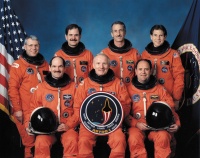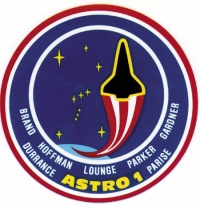STS-35
From The Space Library
 | |
| Organization | NASA-OfficeofSpaceFlight(UnitedStates) |
|---|---|
| Mission type | Astronomy,Human Crew |
| Launch date | December 2, 1990 |
| Launch vehicle | Space Shuttle |
| Launch site | Cape Canaveral, United States |
| COSPAR ID | 1990-106A |
| Experiments | Here |
| Alternate Names | 20980 |
| Additional Information | Here |
| Telecommunications Information | Here |
| Data Collection | Here |
| Payload Mass Up | 11943.08 kg |
STS 35 was the 38th shuttle mission and the tenth flight of the Columbia orbiter. The commander was Vance Brand and the pilot was Guy Gardner. Mission specialists were Jeffrey Hoffman, John Lounge, and Robert Parker. Payload specialists were Samuel Durrance and Ronald Parise. The shuttle landed after completing 144 orbits with a total mission duration of 8 days, 23 hours, 5 minutes, and 8 seconds. Primary objectives were round-the-clock observations of celestial sphere in ultraviolet and X-ray astronomy with ASTRO-1 observatory consisting of four telescopes: Hopkins Ultraviolet Telescope (HUT); Wisconsin Ultraviolet Photo-Polarimeter Experiment (WUPPE); Ultraviolet Imaging Telescope (UIT); and Broad Band X-Ray Telescope (BBXRT). Ultraviolet telescopes mounted on Spacelab elements in cargo bay were to be operated in shifts by flight crew. Loss of both data display units (used for pointing telescopes and operating experiments) during mission impacted crew-aiming procedures and forced ground teams at Marshall Space Flight Center to aim ultraviolet telescopes with fine-tuning by flight crew. BBXRT, also mounted in cargo bay, was directed from outset by ground-based operators at Goddard Space Flight Center and not affected. Other experiments: Shuttle Amateur Radio Experiment-2 (SAREX-2); ground-based experiment to calibrate electro-optical sensors at Air Force Maui Optical Site (AMOS) in Hawaii; and crew conducted Space Classroom Program: Assignment: The Stars, to spark student interest in science, math and technology. Crew experienced trouble dumping waste water due to clogged drain, but managed using spare containers. The mission was cut short one day due to impending bad weather at primary landing site, Edwards Air Force Base, CA. Science teams at Marshall and Goddard Space Flight Centers estimated 70 percent of planned science data achieved.

